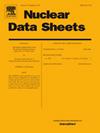A=86等压线的核结构和衰变数据
IF 2.7
1区 物理与天体物理
Q2 PHYSICS, NUCLEAR
引用次数: 0
摘要
对14种已知质量数为A=86的核素(Ga、Ge、As、Se、Br、Kr、Rb、Sr、Y、Zr、Nb、Mo、Tc、Ru)的实验核光谱数据进行了评价。每个反应和衰变都给出了详细的评估信息。结合所有可用数据,提供了每个能级、γ射线和衰变辐射的光谱特性的推荐值。86Ga(基态和一个激发态)、86Ge(6个激发态)和86As(10个激发态)的能级和伽马信息有限,它们各自的β -衰变鲜为人知。86Se、86Br、86Kr、86Rb、86Sr和86Y核的能级和伽马数据相当详细。最近用伽马光谱(2016Ur04)和TAGS技术(2017Ri08)研究了86Br到86Kr的衰变,后者表明86Kr中存在许多在高分辨率γ射线光谱中未检测到的额外水平。2016Ur04的γ射线能谱在Eγ=4MeV范围内有效,而86Br的Q(β)值为7.63 MeV,允许高能能级的居群。对于86Zr、86Nb和86Mo,我们可以获得大部分高自旋态的数据,因为86Nb、86Mo和86Tc的衰变可能会出现在低自旋能级,我们还不太清楚。对于86Tc,从86Tc的同分异构体活性衰变中只知道四个能级。此外,86Tc在86Mo中以g.s. Jπ=(0+)到0+ g.s.的衰变可能涉及超允许β跃迁,这在实验中得到了详细的研究。86Ru只有同位素鉴定,半衰期和衰变模式未知。本研究评估的数据取代了2015年ne01之前对A=86核的ENSDF评估数据,其中文献截止日期为2014年11月30日。本文章由计算机程序翻译,如有差异,请以英文原文为准。
Nuclear Structure and Decay Data for A=86 Isobars
Experimental nuclear spectroscopic data are evaluated for 14 known nuclides of mass number A=86 (Ga, Ge, As, Se, Br, Kr, Rb, Sr, Y, Zr, Nb, Mo, Tc, Ru). Detailed evaluated information is presented for each reaction and decay. Recommended values combining all available data are provided for the spectroscopic properties of each level, γ-ray, and decay radiation. Limited level and gamma information is available for 86Ga (ground state and one excited level), 86Ge (six levels), and 86As (ten excited states), with their respective decays poorly known. Fairly detailed level and gamma data are available for 86Se, 86Br, 86Kr, 86Rb, 86Sr and 86Y nuclei. The decay of 86Br to 86Kr has recently been studied by gamma spectroscopy (2016Ur04) and by TAGS technique (2017Ri08), the latter suggesting that many additional levels in 86Kr exist which have not been detected in high-resolution γ-ray spectroscopy. The γ-ray spectra in 2016Ur04 were valid up to , whereas the Q(β) value of 7.63 MeV for 86Br permits population of high-energy levels. For 86Zr, 86Nb and 86Mo, the data are available for mostly the high-spin states, as the decays of 86Nb, 86Mo, and 86Tc, which could populate low-spin levels, are not known well. For 86Tc, only four levels are known from the decay of an isomeric activity in 86Tc. In addition, decay of 86Tc with g.s. to 0+ g.s. in 86Mo could involve superallowed β transition, which has been pursued experimentally in detail. For 86Ru only the isotopic identification is established, with its half-life and decay modes unknown. The evaluated data in this work supersede data in earlier ENSDF evaluation of A=86 nuclei by 2015Ne01, where the literature cutoff date was November 30, 2014.
求助全文
通过发布文献求助,成功后即可免费获取论文全文。
去求助
来源期刊

Nuclear Data Sheets
物理-物理:核物理
CiteScore
7.80
自引率
5.40%
发文量
22
审稿时长
>12 weeks
期刊介绍:
The Nuclear Data Sheets are current and are published monthly. They are devoted to compilation and evaluations of experimental and theoretical results in Nuclear Physics. The journal is mostly produced from Evaluated Nuclear Structure Data File (ENSDF), a computer file maintained by the US National Nuclear Data Center
 求助内容:
求助内容: 应助结果提醒方式:
应助结果提醒方式:


